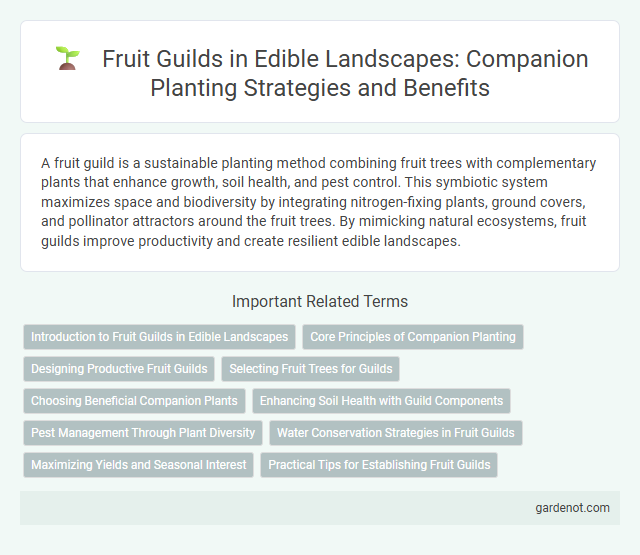A fruit guild is a sustainable planting method combining fruit trees with complementary plants that enhance growth, soil health, and pest control. This symbiotic system maximizes space and biodiversity by integrating nitrogen-fixing plants, ground covers, and pollinator attractors around the fruit trees. By mimicking natural ecosystems, fruit guilds improve productivity and create resilient edible landscapes.
Introduction to Fruit Guilds in Edible Landscapes
Fruit guilds in edible landscapes combine diverse plant species to create mutually beneficial ecosystems centered around fruit-bearing trees and shrubs. These guilds typically include nitrogen-fixing plants, pollinator-attracting flowers, and pest-repellent herbs, enhancing soil fertility, pollination rates, and pest control naturally. Implementing fruit guilds promotes sustainable food production, biodiversity, and resilience within home gardens or larger permaculture designs.
Core Principles of Companion Planting
Fruit guilds employ core principles of companion planting by combining diverse plants that support fruit trees through nutrient cycling, pest control, and pollinator attraction. Nitrogen-fixing species such as clover enhance soil fertility, while dynamic accumulators like comfrey improve nutrient availability and soil structure. Beneficial insect habitats created by flowering plants reduce pest populations, fostering a resilient and productive edible landscape ecosystem.
Designing Productive Fruit Guilds
Designing productive fruit guilds involves strategically combining complementary plants that enhance fruit tree growth, improve soil fertility, and attract beneficial insects. Key components include nitrogen-fixing plants like clover, dynamic accumulators such as comfrey, and pollinator-attracting flowers like borage, which collectively create a self-sustaining ecosystem. Properly integrated guilds increase fruit yield, reduce pest problems, and promote biodiversity within edible landscapes.
Selecting Fruit Trees for Guilds
Selecting fruit trees for guilds involves prioritizing species that provide high yields, pest resistance, and adaptability to local climates. Ideal choices include native or well-adapted varieties like apple (Malus domestica), pear (Pyrus communis), and plum (Prunus domestica), which thrive in guild ecosystems by supporting companion plants and beneficial insects. Incorporating dwarf or semi-dwarf rootstocks enhances manageability and promotes the health of the entire edible landscape guild.
Choosing Beneficial Companion Plants
Selecting beneficial companion plants for a fruit guild enhances soil fertility, pest control, and pollination efficiency. Nitrogen-fixing plants like clover and lupine improve nutrient availability while flowering herbs such as lavender attract pollinators, increasing fruit yield. Deep-rooted plants like comfrey access nutrients from lower soil layers, contributing to overall ecosystem health in edible landscapes.
Enhancing Soil Health with Guild Components
Fruit guilds improve soil health by incorporating nitrogen-fixing plants such as clover and peas, which enrich the soil with essential nutrients. Deep-rooted species like comfrey access and recycle minerals from subsoil layers, enhancing fertility and structure. Mulching plants including strawberries reduce erosion and retain moisture, promoting a balanced and sustainable growing environment.
Pest Management Through Plant Diversity
Fruit guilds enhance pest management by incorporating diverse plant species that attract beneficial insects and repel harmful pests naturally. Companion plants such as marigold, garlic, and chives produce volatile compounds that deter common orchard pests like aphids, codling moths, and spider mites. This biodiversity reduces reliance on chemical pesticides, promoting a healthier and more sustainable edible landscape ecosystem.
Water Conservation Strategies in Fruit Guilds
Fruit guilds incorporate water conservation strategies such as mulching and the use of drought-tolerant companion plants to reduce evaporation and improve soil moisture retention. Deep-rooted species in the guild enhance water infiltration and distribution, promoting resilience during dry periods. Efficient water management supports healthy fruit tree growth and sustainable yields in permaculture systems.
Maximizing Yields and Seasonal Interest
Fruit guilds maximize yields by combining complementary plants that enhance pollination, pest control, and nutrient cycling around fruit trees. Incorporating nitrogen-fixing ground covers, dynamic accumulators, and flowering herbs extends seasonal interest and promotes healthy growth throughout the year. Strategic layering and diverse plant selection optimize space and productivity in edible landscapes.
Practical Tips for Establishing Fruit Guilds
Selecting compatible fruit-bearing plants such as apple, cherry, and berry bushes creates a resilient fruit guild that maximizes yield and soil health. Incorporate nitrogen-fixing plants like clover or lupine to naturally enhance soil fertility and reduce the need for synthetic fertilizers. Mulching with organic materials and planting ground covers helps retain moisture, suppress weeds, and protect root systems in a fruit guild.
Fruit guild Infographic

 gardenot.com
gardenot.com